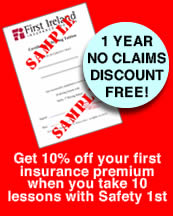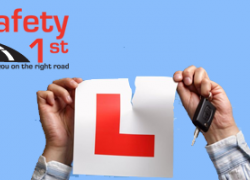You will be asked normally between 3-6 questions on the Rules of the Road by your driver tester inside the test centre. If you get a question or a road sign wrong you will get a Grade 1 fault for "Rules and Checks" at the top of you test sheet. This means that if you get 3 or more signs or questions wrong you will get a Grade 2 fault. This means that you now only have 7 Grade 2´s for you driving and now you have to drive even better to pass it. You cannot fail if you get all of your signs and questions wrong.
** This symbol indicates that it is a commonly asked question and I would advise you to spend more time learning these questions.
PLEASE LEARN THEM ALL!! There is now no excuse for you to lose a Grade 2 on your sheet for "Rules and Checks" This Grade 2 may be the difference of success and failure. Please do not leave studying them to the last minute.
** When approaching a traffic light which is green and then turns to AMBER what should you do?
ANS: You should stop unless it is unsafe to do so.
Can you give examples of when it would be unsafe to stop?
ANS:
(a)When you´re already in the junction and stopping would block the junction
(b)When a vehicle behind you is too close to you where they could crash into you from behind if you were to stop too suddenly.
(c)When you´ve already anticipated that if the lights turn AMBER but you´ve now accelerated to commit to driving through the junction.
**When can you overtake on the left

ANS:
(a) When the driver in front of you is turning right and you intend to go straight ahead

(b) When the driver in front of you is turning right and you intend to turn left

(c) When the traffic in the right hand lane is moving more slowly

On a dual carriageway, should you drive in the left or right lane?

ANS: You should drive in the left hand lane or the lane closest to the left.

At a pedestrian crossing with flashing amber lights, what should you do?

ANS: You may proceed but you must allow pedestrians to cross.

At a stop sign with no white line, where should you stop?

ANS: Stop at the STOP sign.

What position should you take up if you are turning right on a one-way street?

ANS: The extreme right hand side.

How would you turn right on a major road?

ANS: Check your rear and your right wing mirror and indicate to the right. Move into left or centre position or in the lane marked to turn right. Yield right of way to traffic going straight or turning left. When you get a clear gap, make your turn without cutting the corner and yield right of way to pedestrians.

**How would you know a zebra crossing at night time?

ANS: Flashing amber beacons.

What does the island in centre of a pedestrian crossing mean?

ANS: Treat each side of the road as a separate crossing

What restrictions are there in relation of the use of the horn?

ANS: It must not be used between 11.30pm-7.30am in a built up area except in an emergency

**When driving at night, when should you dip your headlights/use dipped headlights?

ANS:
(a) facing oncoming traffic
(b) following closely behind another vehicle
(c) on continuously lit roads
(d) in dense fog and falling snow
(e) at dusk and dawn
(f) when being overtaken by another vehicle

What should you if dazzled by the lights of an oncoming vehicle?

ANS: Look away from the lights or slow down or stop in a safe place if necessary

**What is a clearway?

ANS: You cannot stop or park, during the times shown, except for buses or taxis.

What does a broken yellow line indicate?
ANS: It marks the edge of the road or the hard shoulder.

What does a single yellow line at the edge of a road indicate?

ANS: You cannot park during business hours normally between 9.00am and 5.00pm

What is the legal parking distance from the kerb

ANS: 18 inches or half a metre.

How close to a junction can you park?

ANS: 5 metres.

Where should you not park?

ANS: Near a bend, corner or the brow of a hill, at a double yellow line, opposite another car on a narrow road, outside a private property without the owner�s consent, where your vehicle will obstruct a road sign, in a yellow box, outside a school, bus-stop or taxi rank.

What is the safe distance to drive from the vehicle in front of you?

ANS: 1 metre per mile per hour or DOUBLE in wet conditions or 4 times the normal distance in SNOW OR ICE. or the �two second rule� This means that when the vehicle in front has passed a point in the road, i.e road sign, there should be a clear two seconds gap by the time you reach the same point.

What is the sequence of traffic lights?

ANS: Green, amber, red, green.

**What does an amber light mean?

ANS: You must stop unless it is UNSAFE to do so.

At a junction where traffic lights are not working, to whom should you give right of way?

ANS: Proceed as you would normally, at a T junction, give right of way to traffic in both directions. Wait for a safe and proceed with caution.
**Name three people with the authority for whom you must STOP?

ANS: Garda, school warden or a customs officer.

If you were entering a one-way street at the no entry end, what road marking would you see?

ANS: A continuous white line with a broken white line behind it.

**When can you cross a continuous white line?

ANS: To avoid an obstruction.

**What is the NATIONAL speed limit?

ANS: 100km/h for cars and 80km/h for trucks.

What is the maximum speed on a motorway?

ANS: 120km/h.

**What is the legal minimum thread depth of your tyres?

ANS: 1.6mm.

**What rules apply to a yellow box junction?

ANS: You may not enter it unless you can clear it, except when you are turning right, but without causing an obstruction.

If you have two sets of white lines in the centre of the road, one continuous white line and one broke white line, what rules apply?

ANS: You must obey the continuous white line on your side.

What does two sets of broken white lines in the centre of the road indicate?

ANS: There will be one or two sets of continuous white lines ahead.

What does a broken white line in the centre of the road indicate?

ANS: It is an early warning of danger ahead and you can cross it if it is safe to do so.

How close to a pedestrian crossing can you park?

ANS: 15 metres.

What shape and colour is a warning sign?

ANS: Diamond shape with a yellow background and a black border.

What shape and colour is a regulatory sign?

ANS: Circular shape with a white background and a red border except a STOP SIGN (octagon shape) or YIELD RIGHT OF WAY (triangular shape)

What should always be kept clean on your vehicle?

ANS: Lights, reflectors, mirrors, windows, registration plate.

When should you use your hazards warning lights?

ANS: : When your vehicle is broken down and you can not position your vehicle to a safe position on the left side of the road, when there is an obstruction in the road ahead to warn traffic from behind, when being towed or at the scene of an accident.

What vehicles are not allowed on the motorway?

ANS: Drivers who do not have a full licence, horse-drawn carriages, motorbikes under 50cc i.e mopeds, vehicles who cannot reach 50KPH.


To whom should you give right of way on a roundabout?

ANS: Yield right of way to traffic from your right.

Where should you NOT overtake?

ANS: On a bend, hill or a humpback bridge, at junctions or pedestrian crossings, over a continuous white line, or any situation where you cannot see far enough ahead to ensure it is safe to overtake.

What is the purpose of the hard shoulder?

ANS: You must not STOP on a motorway for any reason but you can pull in on the hard shoulder if your vehicle has broken down.
What does coasting on the clutch mean?

ANS: Pressing the clutch pedal before the brake, travelling in NEUTRAL gear, not releasing the clutch after you change gear, using the clutch as a 2nd brake, staying on the clutch when turning left or right or anytime where you press the clutch without changing gears or stopping.

What should you do if you are feeling tired when driving?

ANS: Pull in at a safe place on the side of the road or if on a motorway, exit at the next slip road and pull in somewhere safely, ie a garage. Walk up and down and breathe in slowly and stretch your arms and legs, drink 2 cups of coffee or take a nap for a minimum of 15 minutes if required.

When should you use your parking or side lights?
ANS: When daylight begins to fade, overcast or dull days or in light rain.

What lights should you have on in a tunnel?
ANS: Dipped headlights unless visibility is good.

Click here for printable version





